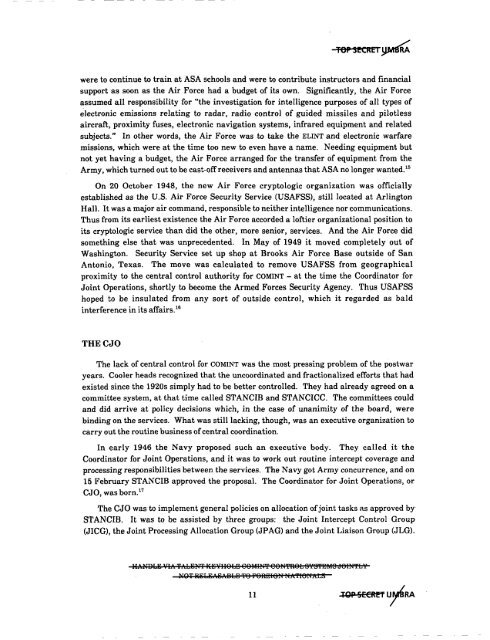American Cryptology during the Cold War - The Black Vault
American Cryptology during the Cold War - The Black Vault
American Cryptology during the Cold War - The Black Vault
Create successful ePaper yourself
Turn your PDF publications into a flip-book with our unique Google optimized e-Paper software.
Te"S!CREI~<br />
were to continue to train at ASA schools and were to contribute instructors and financial<br />
support as soon as <strong>the</strong> Air Force had a budget of its own. Significantly, <strong>the</strong> Air Force<br />
assumed all responsibility for "<strong>the</strong> investigation for intelligence purposes of all types of<br />
electronic emissions relating to radar, radio control of guided missiles and pilotless<br />
aircraft, proximity fuses, electronic navigation systems, infrared equipment and related<br />
subjects." In o<strong>the</strong>r words, <strong>the</strong> Air Force was to take <strong>the</strong> ELINT and electronic warfare<br />
missions, which were at <strong>the</strong> time too new to even have a name. Needing equipment but<br />
not yet having a budget, <strong>the</strong> Air Force arranged for <strong>the</strong> transfer of equipment from <strong>the</strong><br />
Army, which turned out to be cast-offreceivers and antennas that ASA no longer wanted. 15<br />
On 20 October 1948, <strong>the</strong> new Air Force cryptologic organization was officially<br />
established as <strong>the</strong> U.S. Air Force Security Service (USAFSS), still located at Arlington<br />
Hall. It was a major air command, responsible to nei<strong>the</strong>r intelligence nor communications.<br />
Thus from its earliest existence <strong>the</strong> Air Force accorded a loftier organizational position to<br />
its cryptologic service than did <strong>the</strong> o<strong>the</strong>r, more senior, services. And <strong>the</strong> Air Force did<br />
something else that was unprecedented. In May of 1949 it moved completely out of<br />
Washington. Security Service set up shop at Brooks Air Force Base outside of San<br />
Antonio, Texas. <strong>The</strong> move was calculated to remove USAFSS from geographical<br />
proximity to <strong>the</strong> central control authority for COMINT - at <strong>the</strong> time <strong>the</strong> Coordinator for<br />
Joint Operations, shortly to become <strong>the</strong> Armed Forces Security Agency. Thus USAFSS<br />
hoped to be insulated from any sort of outside control, which it regarded as bald<br />
interference in its affairs. 16<br />
THECJO<br />
<strong>The</strong> lack of central control for COMINT was <strong>the</strong> most pressing problem of <strong>the</strong> postwar<br />
years. Cooler heads recognized that <strong>the</strong> uncoordinated and fractionalized efforts that had<br />
existed since <strong>the</strong> 1920s simply had to be better controlled. <strong>The</strong>y had already agreed on a<br />
committee system, at that time called STANCIB and STANCICC. <strong>The</strong> committees could<br />
and did arrive at policy decisions which, in <strong>the</strong> case of unanimity of <strong>the</strong> board, were<br />
binding on <strong>the</strong> services. What was still lacking, though, was an executive organization to<br />
carry out <strong>the</strong> routine business ofcentral coordination.<br />
In early 1946 <strong>the</strong> Navy proposed such an executive body. <strong>The</strong>y called it <strong>the</strong><br />
Coordinator for Joint Operations, and it was to work out routine intercept coverage and<br />
processing responsibilities between <strong>the</strong> services. <strong>The</strong> Navy got Army concurrence, and on<br />
15 February STANCIB approved <strong>the</strong> proposal. <strong>The</strong> Coordinator for Joint Operations, or<br />
CJO, was born. 17<br />
<strong>The</strong> CJO was to implement general policies on allocation ofjoint tasks as approved by<br />
STANCIB. It was to be assisted by three groups: <strong>the</strong> Joint Intercept Control Group<br />
(JICG), <strong>the</strong> Joint Processing Allocation Group (JPAG) and <strong>the</strong> Joint Liaison Group (JLG).<br />
nA~TQbK VIA 'I'A15KN'I' ICKYII9bB 09111Hf'f eeri'fft8b B-YS'f8MB ifem"fbY<br />
11 .+OP SECRET urRA
















